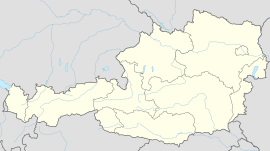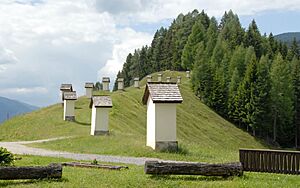Kötschach-Mauthen facts for kids
Quick facts for kids
Kötschach-Mauthen
|
||
|---|---|---|

Main street in Mauthen
|
||
|
||
| Country | Austria | |
| State | Carinthia | |
| District | Hermagor | |
| Area | ||
| • Total | 154.14 km2 (59.51 sq mi) | |
| Elevation | 705 m (2,313 ft) | |
| Population
(2018-01-01)
|
||
| • Total | 3,348 | |
| • Density | 21.721/km2 (56.256/sq mi) | |
| Time zone | UTC+1 (CET) | |
| • Summer (DST) | UTC+2 (CEST) | |
| Postal code |
9640
|
|
| Area code | 04715 | |
| Website | www.koetschach-mauthen.at | |
Kötschach-Mauthen is a lively market town located in the Hermagor area of Carinthia, Austria. It's a great place to visit, known for its beautiful natural surroundings and interesting history.
Contents
Geography of Kötschach-Mauthen
This town is about 34 kilometers (21 miles) west of Hermagor. It sits where the upper Gail Valley meets the Lesachtal valley. Mountains like the Gailtal Alps and Carnic Alps surround it.
Kötschach-Mauthen is an important spot for roads. To the north, a highway goes up to Gailberg Saddle and the town of Oberdrauburg. To the south, another road leads to Plöcken Pass. This pass is on the border between Carinthia and the Carnian region of Friuli, Italy.
Towns and Villages
Kötschach-Mauthen is made up of four main areas: Kötschach, Mauthen, Strajach, and Würmlach. It also includes 31 smaller villages and hamlets.
The largest parts are:
- Kötschach, with about 1,612 people.
- Mauthen, with about 760 people.
- Würmlach, with about 343 people.
- Laas, with about 231 people.
Population Facts
In 2001, Kötschach-Mauthen had 3,613 residents. Most of the people (95%) are Austrian. There are also smaller groups of German and Turkish citizens.
Most residents (89.1%) are Roman-Catholic. About 6.6% are Protestant, and 1.3% are Muslim. A small number of people (1.8%) do not follow any religion.
History of Kötschach-Mauthen
People first settled in this area around 200 BC. You can still see an old rock carving from the Venetian people in Würmlach today. The Romans also built a road over Plöcken Pass. This road led to their province called Noricum. There was a Roman resting place, or mansio, named Loncium near where Mauthen is now. The name Mauthen comes from the German word Maut, which means "toll."
In the Middle Ages, this quiet region grew because of mining. People found iron ore, gold, silver, and lead here. Many of the towns you see today were first mentioned a long time ago. Mauthen was mentioned in 1276, Kötschach in 1308, and Würmlach in 1374.
In the 15th century, the Counts of Ortenburg owned the area. They built a furnace for metalwork, which led to several ironworks. From 1319, Mauthen was an important local court center.
During World War I, the mountains to the south were part of the Italian Front. In 1930, the town was given "market rights." This was to celebrate 10 years since the Carinthian Plebiscite, a vote that decided the region would stay part of Austria. Kötschach and Mauthen joined together to form the municipality of Kötschach-Mauthen in 1958. Later, in 1973, more areas were added to the municipality.
Sights to See
Kötschach-Mauthen has many interesting places to visit.
- Our Lady Parish Church: This church in Kötschach is also known as the "Gailtal Cathedral." It's a great example of late Gothic style. It was first mentioned in 1399 and rebuilt between 1518 and 1527.
- St. Marcus Church: Located in Mauthen, this church was first mentioned in 1466.
- World War I Museum: This museum focuses on the years 1915-1918. It teaches about the war's impact on the area.
- Weidenburg Castle Ruins: These castle ruins were first mentioned in 1225. A new castle was built nearby around 1615.
- Pittersberg Castle Ruins: Another old castle ruin, first mentioned in 1252.
- Mandorf Castle: This late Gothic castle was built in 1521.
Economy and Life
Kötschach-Mauthen is a key town in the upper Gailtal valley. It's also known as the "gate" to the Lesachtal.
Important parts of the local economy include:
- Wood processing: Using wood to make different products.
- Heat exchangers: Making devices that transfer heat.
- Tourism: Many people visit the area.
- Restaurants and hotels: Providing food and places to stay for visitors.
The town is also famous as a wellness and climatic spa. This means it's a place where people go to relax and improve their health. It has a modern swimming pool complex called "Aquarena." This is the biggest indoor and outdoor pool in the Upper Gailtal and Lesachtal areas.
There is a hospital in nearby Laas. It has departments for medical care and for patients with long-term illnesses.
In Würmlach, there are important pipelines. These pipelines carry oil and gas. One goes to Vienna, Austria, and another goes to Karlsruhe, Germany. Since 2005, a special plant in Würmlach has been making gas from natural materials. This gas is then used to power a heating and power station in Kötschach.
Train service for passengers on the Hermagor-Kötschach-Mauthen line stopped at the end of 2016.
Notable People
- Josef Klaus (1910–2001): He was an important politician from this area. He served as the Chancellor of Austria from 1964 to 1970. The Chancellor is the head of the government in Austria.
See also
 In Spanish: Kötschach-Mauthen para niños
In Spanish: Kötschach-Mauthen para niños






